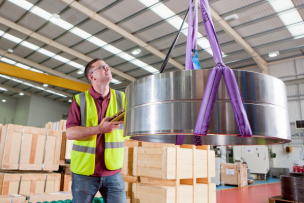From proper care to proper usage—asking the right questions can help keep workers safe.
Falls from roofs, elevated platforms and other high places are one of the most common causes of workplace injuries, accounting for more than one-third of on-the-job fatalities in industries such as construction. Overall, failure to provide adequate fall protection is the most-cited violation of Occupational Safety and Health Administration (OSHA) standards.
In general industry, employees must be protected from falls if they work at a height of 4 feet or more above a lower surface, though the threshold is slightly higher in construction and some other businesses. OSHA’s fall protection rules are several decades old and are currently being revised, but they primarily require passive controls, such as installing guardrails and toe boards on elevated open-sided platforms, walkways and other workspaces.
However, in locations where installing passive controls is difficult or impossible, an employee working at elevation requires a personal fall arrest system (PFAS). Asking the following questions can help ensure that a worker gets adequate protection from a PFAS.
Do your employees have the right fall protection equipment?
There are countless variations on the PFAS, but all include three basic elements: a body harness, which is attached to a lifeline or lanyard, which in turn connects to an anchor.
Ensuring that a harness fits snugly is essential, says Kimberly Messer, corporate marketing manager for LJB Inc., an engineering group that offers training in fall protection. Straps that are too tight could cut off circulation to the legs, while a harness that’s too loose could let a falling employee slip out and plummet to the ground.
Are your employees using PFAS equipment correctly?
“Improper use is a huge issue,” says Messer. A harness that has not been donned according to manufacturer’s instructions could cause harm, such as choking in the event of a fall. A lifeline that’s longer than the drop it’s meant to prevent is worthless, yet Messer sees this mistake often. Improper anchoring is common, too. A falling body produces tremendous force, so the anchor must have adequate tensile strength to handle at least 5,000 pounds. “That’s the weight of a pickup truck,” says Messer. Yet she has seen PFAS equipment anchored to ventilation pipes, metal staircases and other clearly inadequate locations. Proper training for all employees who work in high spots is essential.
Do you inspect fall protection equipment routinely?
Check all components of a PFAS before and after each use to prevent a fall. Even a tiny cut in a lifeline or lanyard can make it unsafe. Exposure to sunlight can harm it, too. Use your hands and eyes to check for snags, holes, frayed fibers and other imperfections in the lifeline or lanyard. Ensure that buckles, D-rings and other hardware are sturdy. Discard equipment that fails inspection and follow manufacturer instructions for annual inspections.
Do you store and care for fall safety equipment properly?
In most cases, harnesses and lifelines or lanyards should be hung up when not in use. Do not store them in a room with paint or chemicals, which may give off gases that damage the fibers. Clean them occasionally with soap, water and a light brush.
Is your fall protection equipment outdated?
Check the manufacturer’s recommendations to determine the life span of the components in a PFAS. However, as a rule of thumb, this equipment should be replaced every five years.
What other tips do you use for keeping fall safety harnesses in working condition?


Talk to Us!
On a low pitch residential home roof, how can we tie off if the homeowner says we cannot put an anchor into their roof?
37I have a contractor repairing a metal roof. Replacing 10 skylites with solid metal panels to include ridge cap. Fall distance at roof edge is 10 ft. Is a full harness with lanyard to a tie off point at ridge is the appropriate system. The panels extend from ridge appx have the length. Personnel will stay appx 8 ft. from roof edge
46Hi Billy,
See the additional article on Better MRO.
https://www.mscdirect.com/betterMRO/safety/how-osha-guardrail-requiremen...
In general, “If there is 6 feet or less from the leading edge, a conventional fall protection system (such as a guardrail system, a personal fall arrest system or a safety net) must be used, says Leading Edge Safety. If the distance is between 6 and 15 feet from a leading edge, a designated area for temporary work is required, with a warning line that must be placed at 6 feet.”
The article references the standards, so please consult those as well.
60Leave a reply
Your email address will not be published. Required fields are marked *